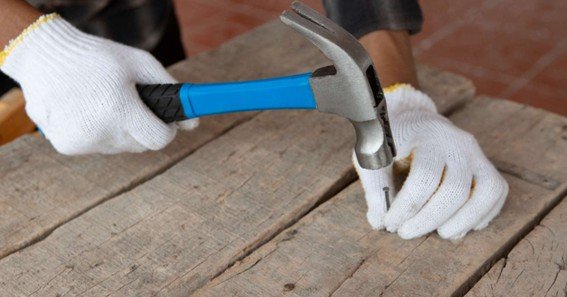When undertaking roofing projects, selecting the appropriate tools is crucial for efficiency and quality workmanship. A shingling hammer, specifically designed for roofing tasks, stands out as an indispensable tool for professionals and DIY enthusiasts alike. But why is a shingling hammer ideal for roofing work? Let’s delve into its unique features and benefits.
Key Features of a Shingling Hammer
- Dual Functionality
A shingling hammer typically combines a traditional hammerhead with a hatchet or blade on the opposite side. This design allows roofers to drive nails and cut shingles without switching tools, enhancing efficiency on the job.
- Integrated Gauge
Many shingling hammers feature an adjustable gauge on the head, assisting roofers in achieving precise shingle exposure. This ensures uniformity and accuracy in shingle placement, contributing to the overall aesthetics and functionality of the roof.
- Magnetized Face
The magnetized face of some shingling hammers holds nails in place, facilitating one-handed nailing. This is particularly beneficial when working on sloped surfaces or in tight spaces, reducing the risk of dropped nails and increasing safety.
- Ergonomic Design
Modern shingling hammers are designed with ergonomics in mind, featuring comfortable grips and balanced weight distribution. This reduces user fatigue during extended periods of use, allowing for more prolonged and productive work sessions.
Benefits of Using a Shingling Hammer
- Efficiency
The multifunctional design of a shingling hammer minimizes the need to switch between tools, streamlining the roofing process and saving valuable time.
- Precision
With built-in gauges and magnetized faces, shingling hammers enable precise shingle placement and secure nailing, ensuring a high-quality finish.
- Versatility
Beyond driving nails, the hatchet or blade component allows for cutting and trimming shingles, making the shingling hammer a versatile tool for various roofing tasks.
FAQ
- What distinguishes a shingling hammer from a regular hammer?
A shingling hammer is specifically designed for roofing, featuring a dual-sided head with a hammer on one side and a hatchet or blade on the other, along with additional features like an integrated gauge and magnetized face.
- Can a shingling hammer be used for tasks other than roofing?
While primarily designed for roofing, a shingling hammer’s versatile features can be useful in other carpentry tasks, though it may not replace specialized tools for non-roofing applications.
- How does the integrated gauge on a shingling hammer work?
The adjustable gauge helps set the correct shingle exposure by providing a consistent reference point, ensuring uniform placement across the roof.
- Is a magnetized face essential on a shingling hammer?
While not essential, a magnetized face enhances convenience by holding nails in place, allowing for one-handed operation and increased efficiency.
- What should I consider when choosing a shingling hammer?
Consider factors such as weight, handle material, balance, and additional features like a magnetized face or adjustable gauge to ensure it meets your specific roofing needs.










